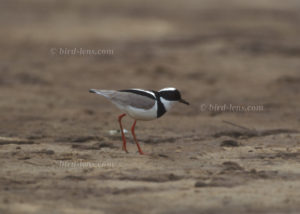 A Lapwing is standing on a sandbar on the north bank of the Rio Cuiabá (on some maps, this section of the river also Rio São Lourenço). It is a conspicuous black and white colored small wader which obviously uses the southernmost end of the Transpantaneira as his homeground. The Pied Lapwing (Vanellus cayanus) is quite a common bird on sandy shores along the rivers of the Pantanal in central Brazil. In the meantime, this lapwing has gotten a new scientific name: Hoploxypterus cayanus. The north bank of the Rio Cuiabá at Porto Jofré is the end of a 145 kilometers stretch of the Transpantaneira. Apart from a few houses, a simple campsite, boat moorings and the huge grounds of Hotel Pantanal Norte, there is not much to see here. On the river a few houseboats dangle on the opposite shore. Swiftly the white-black bird runs in front of me on the sand of the Rio São Lourenço/ Rio Cuiabá. Again and again the small wader pauses and seems hesitant to start moving again. I lay down on the sand and let the bird come. Over time, the Pied Lapwing gets closer and closer. I decide to stay in the sand and take a few photos with the 4.0 / 500 also from the other waders on the sandbank.
A Lapwing is standing on a sandbar on the north bank of the Rio Cuiabá (on some maps, this section of the river also Rio São Lourenço). It is a conspicuous black and white colored small wader which obviously uses the southernmost end of the Transpantaneira as his homeground. The Pied Lapwing (Vanellus cayanus) is quite a common bird on sandy shores along the rivers of the Pantanal in central Brazil. In the meantime, this lapwing has gotten a new scientific name: Hoploxypterus cayanus. The north bank of the Rio Cuiabá at Porto Jofré is the end of a 145 kilometers stretch of the Transpantaneira. Apart from a few houses, a simple campsite, boat moorings and the huge grounds of Hotel Pantanal Norte, there is not much to see here. On the river a few houseboats dangle on the opposite shore. Swiftly the white-black bird runs in front of me on the sand of the Rio São Lourenço/ Rio Cuiabá. Again and again the small wader pauses and seems hesitant to start moving again. I lay down on the sand and let the bird come. Over time, the Pied Lapwing gets closer and closer. I decide to stay in the sand and take a few photos with the 4.0 / 500 also from the other waders on the sandbank.
In addition to the Pied Lapwing I dedicate a lot of time especially to the Collared Plover (Charadrius collaris). With their chestnut-brown neck, gray-brown mottled coat and pure white bottoms, they are very rich in contrast. There is also a black chest band. The male I photograph has a white forehead bounded by a black frontal strip and at the bottom by a black eyestripe. Strikingly are the long pinkish legs.
On the north bank of the Rio Cuiabá the vegetation is greener again than along the Transpantaneira further north. This is true at least in the dry season. Because here at the Rio São Lourenço water is available throughout the year. The flooded plain Campo Jofré is very impressive, the wide river flows lazily in front of you. The area is quite reminiscent of the Okavango Delta in Botswana. Here there is a large concentration of wild animals of which Jaguars (Panthera onca) are certainly the most famous.
Many who have gone so far now have to board a boat and reach deep into their pockets. This is especially true for those who want to see jaguars. In the past only fishermen came here. For sightings of the jaguars, which are called Onça pintada here, you drive from Porto Jofré mostly upriver to the Parque Estadual Encontro the Águas. Actually, the park should now be developed for tourism. That is not the case yet; and maybe it’s better that way. Tourists, guides and scientists come here daily to watch the jaguars from the boat on the shore. The 1,081 km² State Park is bounded on the north by the Rio Caçanje, which flows into the Rio Cuiabá. Further south, the Rio Alegre flows through the park, flowing into the Rio Caçanje, and both end in the Rio Cuiabá, which marks the eastern boundary of the park. From the east, two more rivers flow into the Rio Cuiabá, the São Lourenço and the Rio Pingara. In the south on the Rio Piquirí is not only the park boundary, here also begins the state of Mato Grosso do Sul. With the chaos of the many meandering rivers in this floodplain, it is difficult to keep track.
To cope with the growing demand for top shots of the rarer species of the Palearctic Bird-Lens is keen to enrich the range of pictures of birds not only in the western palearctic. Trips to remote places like this one to capture images were very successful. The nice image of the blog is only a first impression, what you will find in the gallery in the “Picture Shop” very soon. Just give bird-lens.com a message, if www.bird-lens.com could serve you with an image needed before the new pictures are online.